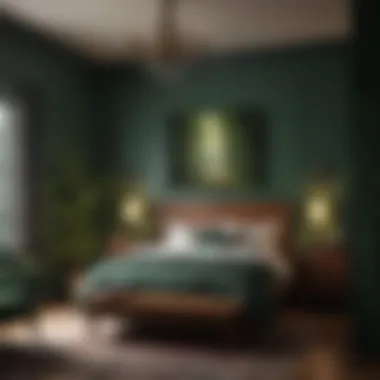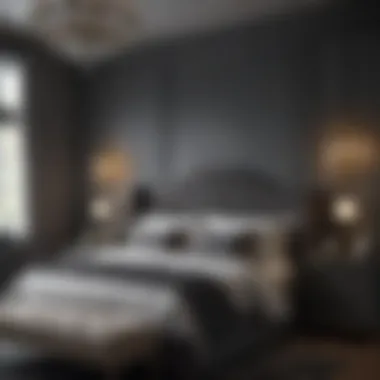Exploring Dark Bedroom Paint Colours for Comfort


Intro
Choosing paint colors for your bedroom can be a daunting task. It’s not just about picking your favorite shades; it’s about creating a space that feels welcoming, intimate, and reflective of your personal style. Dark bedroom paint colors have gained traction for their ability to transform a room from mundane to extraordinary. They can evoke a sense of coziness akin to a warm hug, while also offering a sophisticated edge that lighter colors simply can’t achieve.
This article will dive into the depths of exploring dark paint colors for bedrooms, examining how they affect our emotions, and how they can be integrated into different design principles. We’ll delve into trending styles, ideal palettes, and completion techniques that allow homeowners to create their own little sanctuaries of relaxation and comfort.
Trending Styles
Dark hues can be undeniably versatile, fitting seamlessly into various style preferences. There are two that have particularly risen to popularity among decorators and homeowners alike.
Modern Minimalism
Minimalism speaks to the heart of simplicity, where every piece in the room has significance. In a dark bedroom painted in shades like charcoal gray or navy blue, you get depth without overwhelming the senses. The unadorned surfaces of furnishings, coupled with carefully curated decorations, can stand out beautifully against a dark backdrop. Just imagine a sleek, low-profile bed dressed in crisp white linens, paired with a darkened accent wall to draw the eye.
Cozy Rustic
In contrast, a cozy rustic style embraces warmth and natural elements. Using dark earthy tones such as deep forest green or warm brown can evoke a sense of connection to nature. Imagine wooden beams overhead and perhaps a plush quilt thrown haphazardly over the foot of the bed. The room becomes a sanctuary, a place where you can escape from the fast-paced world outside. The combination of dark paint tones with wood textures creates balance and harmony, inviting you to relax.
Color Palettes
When considering dark colors, it's essential to think about the harmony and contrast within your chosen palette.
Calming Neutrals
Neutral shades like beige or off-white can work wonders when combined with darker colors. These hues reflect light and can prevent the room from feeling too enclosed. Think of a restful taupe accentuating a deep navy; the two can play off each other beautifully, supporting a serene environment. Incorporating soft lighting fixtures can also enhance the calming effect, making the space feel open and airy despite its darker tones.
Bold Accents
For those eager to make a statement, integrating bold accents alongside dark paint can elevate the room’s sophistication. A bright piece of artwork or an eye-catching rug can serve as focal points, adding life and energy to the space. Mix in metallic elements such as brass or gold tones in light fixtures or decorative accents; they pair astonishingly well against darker colors and can bring warmth and richness to the atmosphere.
"The secret of a dark bedroom lies not only in the color of the paint but also in the careful selection of decor and the strategic use of light to create a balanced space."
Finding the right balance while embracing dark colors is key to crafting a bedroom that feels personal and cozy. Through a deeper look into these styles and palettes, homeowners can embark on a journey toward creating a serene retreat that reflects their tastes and comforts.
Understanding Dark Colours in Design
Dark colours in design serve as a powerful tool for homeowners wishing to create unique and engaging spaces. These hues can drastically transform the atmosphere of a room, going beyond mere aesthetics. Using darker tones can influence mood, impact perceived space, and create a depth that lighter shades cannot achieve.
The Psychology of Colour
The colours we choose to surround ourselves with speak volumes about our character and how we engage with the world. Dark colours, for instance, evoke a dense range of emotions. They can convey sophistication, support relaxation, or indeed project introspection.
When you opt for dark paint in your bedroom, you’re not simply choosing a colour; you’re creating an ambiance. Shades like navy blue or deep charcoal can cultivate a sense of calm, ideal for winding down at day's end. Conversely, colors such as black can stimulate a more dramatic feel, suggesting elegance or even mystery. Understanding these emotional triggers is the first step in your colour journey.
Emotional Responses to Dark Tones
People often have varied emotional responses to dark colours that depend on their life experiences, contexts, and cultural backgrounds. For example, deep green may remind someone of lush forests and serenity, while others might feel confined in that same hue.
Choosing dark tones also taps into a sort of comfort, resembling nature’s depth — think of an evening sky or a quiet forest at dusk. These colours can create a sense of security, much like wrapping oneself in a cozy blanket. Here are a few emotional associations that dark colours often stir:
- Comfort: Many find dark tones enveloping, giving a cozy feel to a room.
- Sophistication: A black wall often adds elegance and a high-end feel to a space.
- Introspection: Dark hues can provoke deeper thoughts and reflections, a perfect trait for a bedroom sanctuary.
In summary, understanding how dark colours work in design not only enhances your ability to create beautiful spaces but also allows you to consciously influence the emotional experience of those who inhabit them.
Benefits of Dark Bedroom Paint
In the realm of interior design, the choice of color plays a pivotal role in shaping the ambience and emotional experience of a space. When it comes to bedrooms, opting for dark paint colors can transform an ordinary room into a sanctuary of relaxation and intimacy. The principles governing color usage reveal that dark hues often convey particular benefits that cater to comfort and aesthetic appeal.
Creating a Cozy Atmosphere
One of the prominent advantages of using dark paint in bedrooms is the creation of a cozy atmosphere. Dark shades absorb light, which can make a space feel snug and inviting. Unlike lighter colors that may echo an open feeling, darker tones have a way of enveloping you, creating a retreat from the hustle and bustle of daily life. This enveloping effect can be especially comforting during colder months or in regions with less sunlight.
- Warmth: Dark colors often evoke feelings of warmth. For instance, a deep burgundy can reflect both richness and warmth, akin to sitting by a fireside.
- Intimacy: A dark-painted room can feel more personal; it encourages a sense of enclosure that enhances private moments.
- Versatility: With dark walls, you can play with the addition of various textures, fabrics, and decor items to enhance that cozy feel even further, integrating elements like soft throws or lush pillows.
The choice of a dark shade, like deep blue or charcoal, can visually reduce the size of a room, therefore increasing its allure. Often, when you walk into a room with such tones, the immediate response is one of comfort and safety, much akin to curling up under a warm blanket on a chilly night.
Enhancing Intimacy and Comfort


The emotional responses that dark tones evoke cannot be overlooked. Their inherent depth contributes to a scene of intimacy and comfort, making them ideal for bedrooms where relaxation and closeness matter.
- Psychological Effect: Darker hues can provide psychological comfort, promoting feelings of tranquility and security. Many people gravitate toward these colors for personal spaces, feeling a sense of relief wrapped in the shelter provided by dark walls.
- Designed for Connections: Bedrooms are not just for sleeping; they’re spaces for nurturing relationships. Dark colors can enhance romantic feelings and encourage deeper connections. For example, imagine a navy blue wall paired with soft gold accents, creating an atmosphere that whispers elegance and intimacy.
- Focal Points: Using dark colors as a backdrop allows decor pieces to stand out more prominently. Whether it’s a cherished artwork or a family photo frame, the darker tones provide a striking contrast that draws attention while enhancing the intimate vibe of the setting.
"In the world of color, darker shades bring a sense of complexity and richness that lighter tones simply cannot match."
In summary, the benefits of dark bedroom paint are substantial. They create a cozy atmosphere and enhance intimacy and comfort, providing a perfect background for personal moments. As such hues continue gaining popularity, they invite homeowners to strike a balance between aesthetic desire and emotional need.
Popular Dark Colours for Bedrooms
Exploring dark colours for bedrooms is important, as they can create a mood that is both cozy and visually striking. Selecting the right dark hue can turn a simple space into an inviting retreat. Popular dark colours don't just influence the look; they can also affect how one feels in the room. The depth of these colours adds richness and sophistication. They often serve as a backdrop that highlights furniture and decor, making them essential for homeowners aiming to achieve a polished aesthetic while maintaining warmth.
Elegant Blacks
Black, often seen as a bold choice, can actually bring an understated elegance to any bedroom. It isn’t just about painting all four walls black; the beauty lies in its versatility. Using black can create a chic and modern vibe when paired with metallics or lighter shades. For instance, a black wall behind a bed can make the bed frame and linens pop, drawing the eye and creating a dramatic focal point. Careful selection of lighting is crucial; soft lighting can bounce off black surfaces, softening the effect.
Deep Charcoals
Charcoal grey presents a slightly softer alternative to traditional black. It holds the same gravitas but feels less imposing. This colour can beautifully complement natural wood tones and plush fabrics. Consider a deep charcoal for a feature wall while the other walls remain lighter, giving a sense of balance and serenity. Its neutrality allows you to experiment with various accent colours, from vibrant jewel tones to soft pastels.
Rich Navy Blues
Navy blue evokes feelings of calm and tranquility, much like the night sky. When enveloped in navy, the room can feel like a serene cocoon. This colour pairs excellently with whites and warm metallics — imagine crisp white bedding against a navy backdrop, creating a striking contrast that is pleasing to the eye. This versatility allows for experimentation with textures and patterns, making navy a fantastic choice for adding personality without overwhelming the senses.
Luxurious Hunter Greens
Hunter green speaks of nature’s richness and can transform a bedroom into a restful escape. This deep shade works wonderfully with earthy tones and wooden accents. Using it in a room filled with plants creates a harmonious connection to the outdoors. The mood evoked by hunter green can inspire relaxation, enhancing the feeling of comfort essential for a restful night’s sleep.
Burgundy and Plum Shades
Burgundy and plum aren’t just for wine lovers; these rich shades can infuse a space with warmth and a touch of glam. They can bring sophistication without feeling too heavy. When applied in the right places, they can add character and depth while remaining inviting. Consider using these tones for bedding or curtains if painting all the walls feels too intense. They can also be lovely as accent colours, helping to create a cozy ambiance without dominating the room.
Incorporating dark colours in bedroom design involves understanding both the aesthetic qualities and the emotional responses they trigger.
Opting for a darker shade doesn’t mean sacrificing lightness or airiness; rather, it’s about finding the right balance. It’s clear that popular dark colours serve as more than just paint; they are tools for crafting an atmosphere that resonates with comfort and sophistication.
Combining Dark Colours with Other Hues
Incorporating dark colours into your bedroom design can seem daunting. Yet, blending them with other hues opens a treasure chest of possibilities, enriching the space with depth and character. Understanding how to do this effectively can lead not only to a visually pleasing environment but also to a balanced atmosphere that conveys comfort and elegance. By thoughtfully combining shades, you can create layered aesthetics that provide warmth and personal expression.
Contrasting Light Accents
Contrasting light accents against dark backgrounds acts like a lively dance of light and shadow. Imagine a deep navy blue wall adorned with crisp white or soft cream trims. This not only creates a striking contrast but also highlights architectural details and furnishings against the darker palette. Light accents can include anything from furniture pieces to decorative elements like picture frames or cushions.
- Draws Attention: This technique adds a focal point in a room, guiding the eye naturally to what you want to showcase.
- Balances Visual Weight: While dark colours may feel heavy, light accents can lift the mood. It prevents your bedroom from feeling too enclosed or drab.
- Enhances Mood: A carefully placed touch of light can encourage a feeling of airiness, striking a harmonious balance amidst darkness.
Using light accents does not mean you have to stick to white or neutral tones. Soft pastels or muted colours can infuse a subtle vibrancy that uplifts the entire scheme, creating a cocooning feeling without overwhelming the senses.
Monochromatic Schemes
Monochromatic schemes take the cake when it comes to simplicity and sophistication. This approach involves using varying shades and tints of a single colour, which could be a dark one like charcoal grey or ink black. Here’s why it's worth considering:
- Visual Cohesion: A monochromatic palette provides a seamless flow of colours, making the space feel unified and well-thought-out.
- Depth and Texture: By varying the shades, you can create a layered look that feels richer and more dynamic. For instance, pairing a slate grey with a slightly lighter gunmetal can add an appealing depth to the wall.
- Complementing Decor: With a monochromatic scheme, it’s easier to select decorative elements, fabrics, and art pieces that resonate with the colour scheme, thus enhancing overall harmony.
Incorporating textures in monochromatic settings allows for contrast without changing hues. Textured throws or plush rugs can act as visual breaks and maintain interest while sticking to the same colour family.
Accent Walls and Features
An accent wall stands as a dynamic centerpiece in room design. Using dark colours on one wall while keeping others lighter can add significantly to the space’s charm. The accent wall doesn’t just serve as a backdrop; it can transform the entire mood of the room. Here’s how to master the art of accents:
- Focused Attention: An accent wall can draw attention to a specific part of the bedroom, be it a bed or a piece of artwork, turning an ordinary space into a stunning feature.
- Layered Lighting: When dark colours interact with lighting, the play between light and shade can create a dramatic effect, illuminating details and textures over the darker hue.
- Creative Expression: This approach allows homeowners to express individuality, portraying personal style with daring colours or patterns that may not work throughout the entire space.
Using wallpaper or textured paint for accent walls adds another layer of design possibility, turning a single wall into a canvas that reflects your taste.
Ultimately, combining dark colours with other hues is not just about aesthetics; it’s about creating a sanctuary that resonates with your spirit.
By knowing how to mix and match colours thoughtfully, you can achieve a unique ambience that speaks to both comfort and style.
Preparation for Painting Dark Colours


When thinking about dark bedroom paint, preparation is a key step that shouldn’t be overlooked. The rich shades can add a touch of sophistication and warmth, but they require careful groundwork to bring out their full potential. Skipping this step can lead to uneven finishes, unattractive streaks, or even poor adhesion, resulting in a disappointing experience down the line.
To fully embrace the moodiness that dark colors can bring, care must be taken to ensure the walls are not only prepped but are also primed for transformation. This prepares your space for the profound impact that darkness can have.
Choosing the Right Finish
Getting the right finish can make or break the overall effect of your dark bedroom. With numerous options available, from matte to glossy, it’s about finding the sweet spot for your needs. Here’s a quick rundown of finishes:
- Matte Finishes: Great for absorbing light, creating a serene ambiance, but they may not be the easiest to clean.
- Eggshell Finishes: This is a nice middle ground—offers low sheen, easier to wipe down, and helps to smooth out imperfections on the wall.
- Satin Finishes: A bit shinier and more reflective, satin can bring out the color in deeper tones beautifully.
- Semi-Gloss and Gloss: Might not be the best choice for larger surfaces as they can make imperfections stand out, but are excellent for trim or accents.
Finding a finish that works with the overall design can help create harmony in the room. This little choice can significantly affect your space's appearance and feel.
Surface Preparation Techniques
To simply throw paint on the wall—even if it’s a magical shade of navy or rich charcoal—would be like icing a cake without baking it first. Here are the surface preparation techniques to consider:
- Cleaning the Walls: Dust, grease, or grime can adversely affect how paint adheres. A good scrub down with warm, soapy water can remove any unwanted residue.
- Repairing Imperfections: Inspect the walls for any cracks or holes. Fill these with spackle or joint compound and sand them smooth. A flat surface makes the paint job look top-notch.
- Priming: This is a step many might overlook, thinking dark colors can go straight onto the wall. But a quality primer is crucial for sealing the surface, avoiding undue soaking of the final color, and enhancing paint coverage.
If your walls were previously painted a light color, a primer can block out existing stains or sheens and truly allow your chosen dark hue to shine.
Tip: Don’t rush the prep phase. Take your time and ensure each step is done correctly, so the result is cohesive and looks professional once completed.
When you pay attention to these details in the preparation stage, the end result will speak volumes. Your dark bedroom can become not just a place for rest, but a stunning sanctuary that reflects your unique taste and sense of style.
Techniques for Application
When it comes to applying dark bedroom paint colors, the approach you take can significantly affect the overall result. The techniques you apply in painting not only determine the visual outcome but also influence the longevity and wear of the paint. Understanding the right methods ensures a smooth, professional-looking finish and creates an inviting atmosphere in your bedroom.
Brushing vs. Rolling
Choosing between brushing and rolling is crucial in the application process. Brushing offers precision, making it ideal for corners, trim, and detailed work around windows and doors. It allows you to get into tight spaces where a roller might miss. However, brushing can lead to visible stroke marks if not done correctly, especially with dark paint.
On the other hand, rolling provides a quicker method for covering large areas, which is particularly useful when dealing with expansive walls. Rollers can apply an even layer, which is often more appealing for solid colors. That said, using a roller may require a brush for the edges and corners to achieve a clean finish. A good compromise might involve using both techniques: roll the main surface and brush the details for a pristine look.
Using Primer Effectively
Priming is a step that ought not to be skipped, especially when dealing with dark paints. A high-quality primer prepares the surface, ensuring that the final coat adheres well and appears vibrant. When you’re painting dark colors over light shades, a primer can help prevent the prior color from showing through. A tinted primer, close to your dark paint shade, can also enhance the coverage of your color.
Using primer can actually save you time and paint, allowing you to achieve fullness in color with fewer coats. Just remember to allow the primer to dry completely before moving on to the main paint. This will prevent any unsightly streaks or uneven patches that could mar your efforts.
Layering for Depth
To achieve a rich, engaging finish with dark paint colors, consider the technique of layering. Applying multiple thin coats of color instead of one thick one can create depth and complexity. This may also reveal subtle undertones in the paint that come alive in varying light conditions.
Begin by applying a base coat and allow it to dry thoroughly. After that, apply subsequent layers, lightly sanding between coats if needed. This method allows the layers to meld together, creating an inviting atmosphere rather than a flat appearance.
"Gradation and layering are essential to reviving dark hues, giving them personality and life."
For best results, ensure even application, avoiding drips and lap marks. Utilizing a paint flatter or foam roller can sometimes help achieve that professional quality, making your efforts stand out beautifully.
By mastering these techniques, you’ll not only enhance the aesthetic appeal of your dark bedroom paint but also ensure a durable finish that stands the test of time.
Maintaining Dark Painted Walls
Keeping dark painted walls in good condition requires a bit of forethought and care. While these deep, rich colors can provide a dramatic flair, they also demand proper maintenance to keep them looking their best. Understanding the specifics of maintaining these hues not only helps sustain their striking visual appeal but also extends their longevity.
Cleaning Techniques
When it comes to cleaning dark walls, an effective approach can make all the difference. Dark colors tend to show dust and smudges more easily than lighter shades. To maintain their beauty, here are several techniques worth considering:
- Gentle Dusting: Use a soft microfiber cloth or a feather duster to gently remove dust. Avoid anything too abrasive, which could scratch the paint surface.
- Damp Cloth Wipe: For stubborn spots, create a mixture of warm water and a few drops of mild dish soap. Lightly dampen a cloth with this solution, wringing it out to avoid excess moisture, and wipe down the walls.
- Spot Cleaning: When dealing with specific stains such as crayon marks or finger smudges, applying a cotton swab or piece of cloth dipped in a solution of equal parts vinegar and water can be effective. Be gentle to avoid damaging the paint.
- Avoid Harsh Chemicals: Steer clear of ammonia or bleach, which can discolor or dull the paint finish.
Maintaining dark painted walls means regularly tending to their needs and cleaning them thoughtfully. After all, a clean wall is not only visually pleasing but also contributes to a more inviting space.
Touch-Up Tips
Over time, even the most careful homeowners may notice areas on their painted walls that need a bit of refreshing. Touching up dark colored walls can sometimes be a bit tricky, but with the right strategies, you can do it seamlessly. Here are some considerations:


- Use Original Paint: Always try to use the same paint can that was used for the original job. If that's not possible, check the paint's name and color code. It's crucial for consistency.
- Application Method: When touching up a spot, use a small artist brush or a foam roller. This will help provide a nicer finish compared to a standard paintbrush.
- Feathered Edges: Gently feather the edges of the touched-up area into the surrounding paint. This can help create a more seamless transition, especially with dark colors that are prone to looking uneven.
- Test Areas: Before applying paint, do a spot test in an inconspicuous area to ensure the new paint matches well.
- Timing Matters: When the weather is moist or extremely humid, it affects how paint dries and may lead to different shades on touch-ups. Try to choose a drier day for this task.
Maintaining dark painted walls might take a little extra effort, but the results are worth it. Keeping them clean and fresh not only enhances the aesthetics of your room but also provides a cozy, comforting sanctuary. By following these techniques, you're investing in a beautiful environment that reflects care and thoughtfulness.
Impact on Room Perception
Understanding how dark colours affect a room's perception is essential when deciding on your bedroom's paint scheme. Dark paint colours can significantly impact the way a room feels, both visually and psychologically. A well thought out choice of hue can transform a space from stark and unwelcoming to warm and inviting, enhancing the overall design aesthetic while also altering the spatial dynamics within the room.
Light Reflection and Absorption
When engaging with dark colours, the first consideration is how they interact with light. Dark hues are notorious for absorbing light rather than reflecting it, which can create a moody and intimate feel. This absorption can help in creating a cozy atmosphere, especially in spaces where tranquility is desired, like bedrooms. However, it’s crucial to balance this effect with appropriate lighting.
A few key points to ponder:
- Natural Light: In a room that receives significant natural light, dark shades can create a lovely contrast, highlighting textures and shapes in the decor. The interplay of light and dark can evoke a dynamic atmosphere, but too much darkness can lead to a cave-like feeling if not balanced.
- Artificial Light: LED or soft yellow bulbs can enhance the warmth of dark walls. Choose lighting that complements your chosen shade.
- Room Size: Smaller bedrooms painted in deep tones may feel even more compact. To offset this, consider using lighter furnishings or strategically placed mirrors to bounce light around the room.
"A well-lit dark room can feel just as spacious as a softly illuminated one in lighter colours."
Spatial Adjustments
Your choice in dark paint also affects spatial perception significantly. This might sound counterintuitive, but darker paint can create a sense of depth that lighter colours often cannot. By drawing the eye inward, a darker bedroom can be perceived as more grounded and secure.
Here’s what to keep in mind:
- Room Layout: The orientation and layout of your furniture play an essential role. For example, large pieces of dark furniture against dark walls can sometimes create a monolithic effect. To prevent this, mix in lighter or contrasting colours.
- Furniture and Decor: Select furnishings that pop against the walls. Choosing accessories in subdued tones can soften the overall look while still maintaining elegance.
- Design Flow: A consistent colour palette across adjoining rooms can make transitions feel seamless. If rooms flow into one another, maintaining a balance of colours can create harmony, ensuring that darker tones don’t feel disconnected from the overall aesthetics of the home.
In essence, while dark colours can be beautiful and bold, they require strategic planning. By being mindful of light and spatial dynamics, you can create a bedroom that feels both sophisticated and inviting.
Incorporating Texture
When it comes to transforming a bedroom, incorporating texture into dark paint colours can add layers of depth and interest that make the space feel both inviting and unique. The interplay of textures against rich, dark hues can create a stunning visual contrast, elevating the overall aesthetic while enhancing comfort. This aspect often gets overlooked in discussions about colour selection, yet it is crucial to create a harmonious environment that speaks to the senses.
Texture can influence how a space is perceived—soft textiles can soften the intensity of dark shades, while rougher surfaces can add a rustic charm. In bedrooms where calmness is key, it's beneficial to think strategically about textures that resonate with personal style and practicality. Natural materials like wood and fabric can warm up a room that's painted in bold navy or deep charcoal, crafting a cozy enclave.
Textured Finishes
The choice of textured finishes can significantly affect the look and feel of dark-painted walls. Instead of opting for a flat coat, consider finishes that bring out the character of the paint. For instance, a matte finish provides a velvety softness, while a satin or eggshell finish can introduce a subtle sheen, reflecting light in a delicate manner. This is important because light plays a pivotal role in how dark colours are appreciated in a room.
Some popular textured finishes include:
- Stucco: Adds a tactile quality that draws the eye and enhances the visual depth of dark colours.
- Knockdown: This technique emerges as a fantastic choice, perfect for achieving an understated elegance with its understated pattern.
- Ombre: A gradient effect that blends darker tones gradually can elevate a wall, lending a modern twist.
"Textures bring a wall to life; they whisper stories of comfort and personal expression."
Integrating these techniques allows individuals to personalize their space. When one thinks of a dark bedroom, there’s often a fear of it feeling cramped or gloomy. But with the right choice of textured finish, it can become a chic, sophisticated retreat.
Layering Fabrics
Layering fabrics in conjunction with dark paint colours adds another dimension of warmth and coziness to your bedroom. Instead of setting one or two fabric elements, which can feel flat against darker walls, consider an arrangement that encapsulates both variety and depth. The trick lies in the mix—combining different textures like cotton, linen, velvet, and wool.
Here are a few ideas to effectively layer fabrics:
- Bedding: Start with a solid dark duvet cover, then add a lighter quilt or throw. Incorporate textured pillows, perhaps in a contrasting material like velvet or fur, for added juxtaposition.
- Curtains: Choose curtains that flow or drape nicely. A sheer overlay can lighten up the natural light that dark walls tend to absorb, providing an airy feel.
- Area Rugs: A plush area rug adds comfort underfoot and can make a bold statement. Choose one with a pattern or texture that complements the wall colour, enhancing the overall theme.
The key is to ensure your choices harmonize well. The more you layer different textures and tones, the more inviting and visually interesting your space becomes. This design strategy not only enhances the aesthetics but also promotes an atmosphere that resonates with relaxation and comfort.
The End and Final Thoughts
As we draw the curtains on our exploration of dark bedroom paint colours, it's essential to reflect on the significance of this topic. The journey into the realm of dark hues is not merely about aesthetics; it intertwines with psychology, emotional well-being, and personal expression. Dark colours can transform a mundane space into a sanctuary that speaks volumes about the inhabitant's personality.
Summarizing Key Insights
In looking back at the various facets covered in this article, several key insights stand out:
- Psychological Impact: Dark colours can evoke a plethora of emotions, providing comfort or creating a moody ambiance. It’s about embracing the effect these tones have on mood and atmosphere.
- Aesthetic Value: From elegant blacks to rich navy blues, dark hues add sophistication and depth to any bedroom. They're not simply about making a statement; they enhance the design narrative.
- Practical Considerations: The application and maintenance of these colours require careful thought. Choosing the right finish and surface preparation can make all the difference in achieving the desired effect. Dark walls invite us to consider practicality just as much as beauty.
"A well-chosen colour has the power to transform not just a room, but the emotional experience it evokes."
- Experimentation Matters: Layering dark tones with textures and contrasting lights can create a unique haven. Encourage creativity in selecting colours, finishes, and complementary decor.
Encouragement to Experiment
Finally, I'd like to encourage readers to take this insight and put it into practice. The world of dark bedroom paint colours offers a canvas for personal expression. Don’t shy away from bold decisions; embrace the opportunity to experiment.
- Try Different Combinations: Mix and match various shades of dark hues with other colours. You might find a combination that resonates with you in unforeseen ways.
- Play with Light: Monitor how different lighting conditions affect the perception of your chosen colours. You may discover that the same shade carries a different vibe, depending on the light.
- Refresh Your Space: Each coat of paint holds the potential for transformation. A simple change could forge a new relationship with your living environment.















